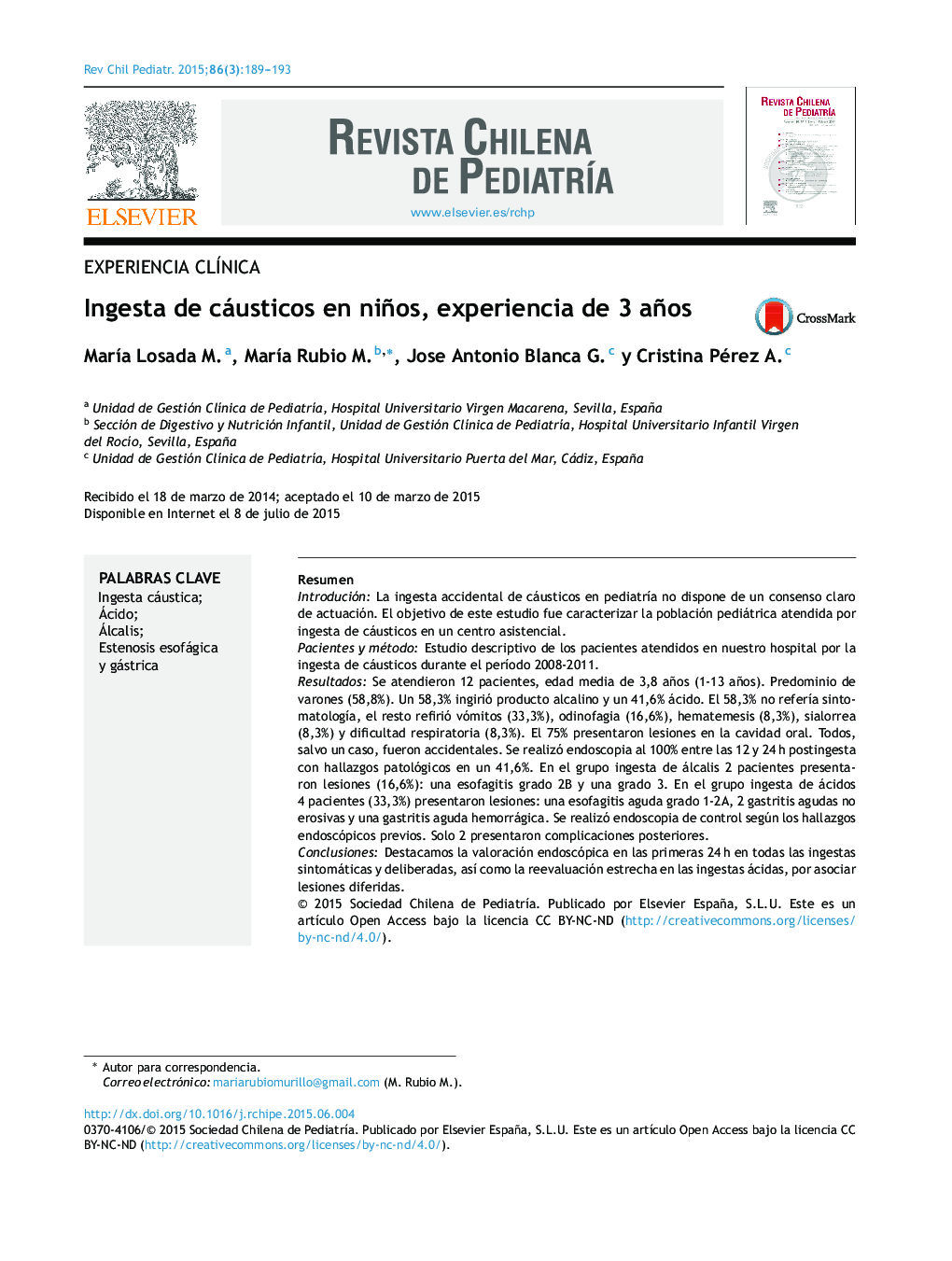| کد مقاله | کد نشریه | سال انتشار | مقاله انگلیسی | نسخه تمام متن |
|---|---|---|---|---|
| 4175901 | 1276224 | 2015 | 5 صفحه PDF | دانلود رایگان |

ResumenIntroduciónLa ingesta accidental de cáusticos en pediatría no dispone de un consenso claro de actuación. El objetivo de este estudio fue caracterizar la población pediátrica atendida por ingesta de cáusticos en un centro asistencial.Pacientes y métodoEstudio descriptivo de los pacientes atendidos en nuestro hospital por la ingesta de cáusticos durante el período 2008-2011.ResultadosSe atendieron 12 pacientes, edad media de 3,8 años (1-13 años). Predominio de varones (58,8%). Un 58,3% ingirió producto alcalino y un 41,6% ácido. El 58,3% no refería sintomatología, el resto refirió vómitos (33,3%), odinofagia (16,6%), hematemesis (8,3%), sialorrea (8,3%) y dificultad respiratoria (8,3%). El 75% presentaron lesiones en la cavidad oral. Todos, salvo un caso, fueron accidentales. Se realizó endoscopia al 100% entre las 12 y 24 h postingesta con hallazgos patológicos en un 41,6%. En el grupo ingesta de álcalis 2 pacientes presentaron lesiones (16,6%): una esofagitis grado 2B y una grado 3. En el grupo ingesta de ácidos 4 pacientes (33,3%) presentaron lesiones: una esofagitis aguda grado 1-2A, 2 gastritis agudas no erosivas y una gastritis aguda hemorrágica. Se realizó endoscopia de control según los hallazgos endoscópicos previos. Solo 2 presentaron complicaciones posteriores.ConclusionesDestacamos la valoración endoscópica en las primeras 24 h en todas las ingestas sintomáticas y deliberadas, así como la reevaluación estrecha en las ingestas ácidas, por asociar lesiones diferidas.
IntroductionThere is no clear consensus on the management of accidental ingestion of caustic substances in paediatrics. The aim of this study was to determine the profile of the paediatric population treated due to caustic ingestion in a Healthcare Centre.Patients and methodA descriptive study was conducted on patients treated for the ingestion of caustic substances in our hospital during the period 2008-2011.ResultsA total of 12 patients were treated, with a mean age of 3.8 years (1-13 years), with the majority males (58.8%). An alkaline product was ingested by 58.3%, and an acid by 41.6%. The majority (58.3%) did not refer to symptoms and the remainder referred to vomiting (33.3%), odynophagia (16.6%), haematemesis (8.3%), hyper-salivation (8.3%) and shortness of breath (8.3%). Oral cavity lesions were observed in 75% of cases. All, except one, were accidental. An endoscopy was performed on all of them (100%) between 12 and 24 hours post-ingestion, with pathological findings in 41.6%. In the group that ingested an alkali, 2 (16.6%) patients had lesions, one a grade 2B and one a grade 3 oesophagitis. In the acid ingestion group, 4 (33.3%) patients had lesions; one grade 1-2A oesophagitis, two acute non-erosive gastritis, and one acute haemorrhagic gastritis. A follow-up endoscopy was performed depending on the previous endoscopic findings. Only two patients presented with complications.ConclusionsEmphasis is placed on the endoscopic evaluation in the first 24 hours of deliberate asymptomatic ingestions, as well as a strict follow-up in those that ingested acids, due to delayed associated lesions.
Journal: Revista Chilena de Pediatría - Volume 86, Issue 3, May–June 2015, Pages 189–193